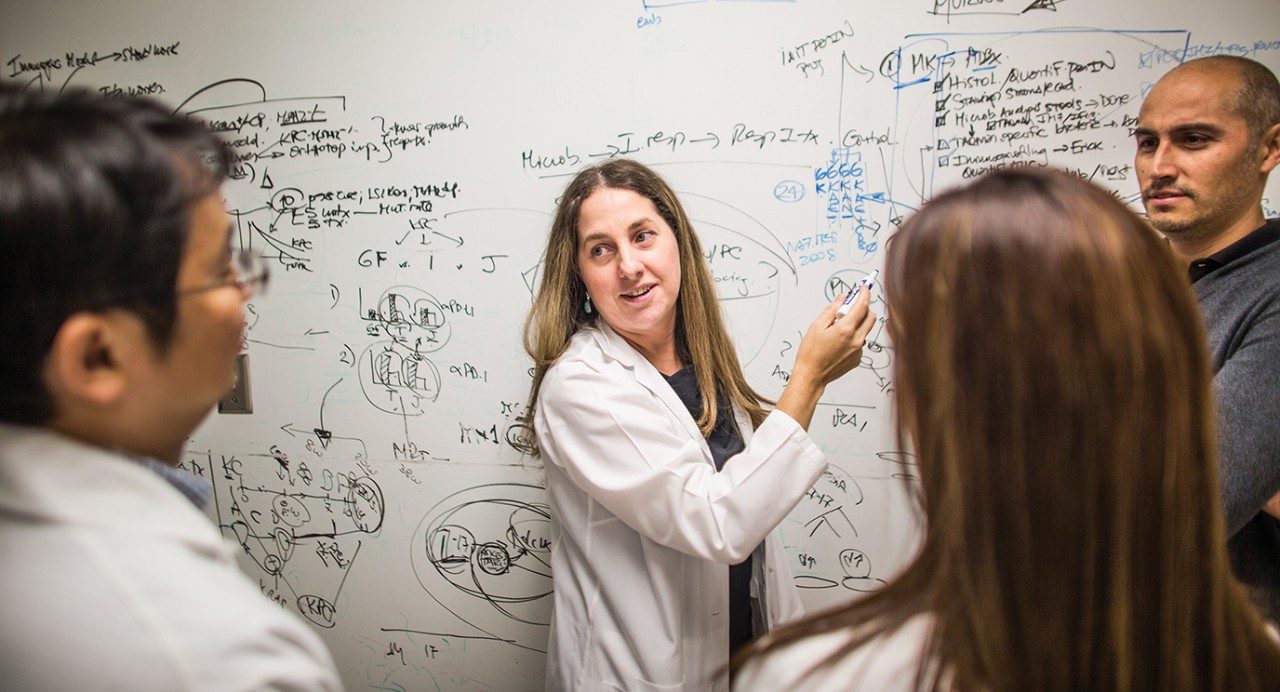Pain overran her life until doctors retrained her brain
Neuromodulation therapies are relieving neuropathy caused by chemotherapy — without the use of opioids.
Yogini Patel tried for eight years to walk without pain, but every step she took was excruciating.
“It was torture,” she says. “Like walking on a bed of nails.”
It turns out the chemotherapy drugs that were keeping Patel's breast cancer at bay for years were also attacking the nerves in her feet, causing a condition called chemotherapy-induced peripheral neuropathy.
“Chemotherapy drugs are formidable weapons in the battle against cancer,” says Sal Abdi, M.D., Ph.D., chair of Pain Medicine at MD Anderson. “But the drugs can't distinguish between healthy and cancerous cells. This means normal cells are damaged along with cancer cells.”
Nerve cells are especially sensitive, Abdi explains, and easily injured. Symptoms of nerve damage start first in the hands and feet, then move toward the center of the body.
Patel says the pain was the hardest part of her cancer treatment. “Every step I took was agony,” she says. “Tears fell from my eyes.
Sometimes I’d drop to my knees.”
Her hands hurt, too, but the pain couldn't compare to what she felt in her feet, which bore all of her weight when standing.
Patel tried to keep going. She navigated grocery store aisles while leaning on a shopping cart. She glued thick sponges to the pedals of her car so she could brake and accelerate without pain. She tried steroid shots, pain patches, creams and sprays. She spent more than a thousand dollars on shoes with soft, padded insoles. Nothing worked.
Eventually, she gave up and began using a wheelchair.
“Movie date nights with my husband were over because I couldn't manage the stairs in the theater,” she says. “Lunches with my friends stopped because I was in too much pain to enjoy meals and conversation. I wore flip-flops even in winter, because shoes and socks hurt. I slept with my feet overhanging the bed, because the weight of the sheet was agonizing.”
Every case is different Patel’s experience is not uncommon.
It's estimated that as many as 90 percent of patients who receive chemotherapy suffer from chemo-induced peripheral neuropathy.
Some begin experiencing it with the first dose of chemo, while others don't feel it until late in their treatments. Some have mild symptoms, while others' are more severe.
Some continue to suffer well after treatment has ended. For others, the neuropathy ends as soon as chemo stops.
Symptoms also vary.
Some patients have pain, but some only feel numbness, tingling and a loss of sensation.
Sometimes their hands and feet get cold; sometimes they're hot. Some people feel as though something heavy is sitting on their legs. Others feel like they're walking on broken glass.
“Every case is different,” Abdi says.
“Because neuropathy is caused by nerve damage, its effect on you depends largely on how well your nerves recover. And that depends on the length of your treatment, the intensity of your chemo dosage, the extent of your nerve damage, and genetic factors that make some people more susceptible to the side effects of chemotherapy.”
Reclaiming her life
Patel eventually began taking opioid medications to lessen her pain, but the pills made her drowsy and “zoned out.”
“I hated taking them, but the pain was unbearable,” she recalls. “I went to bed in the early afternoon and didn't get up until the next day.”
One morning, Patel woke up and asked herself, “Where have the last few years gone?” “I threw those pills away,” she says. “I’m a very independent woman. I wanted to wake up and enjoy life, not float around in a fog.”
At the time, Abdi was trying a new type of pain treatment that was free of drugs and side effects.
Scrambler therapy, as it's called, uses low doses of electrical stimulation to reset — or “scramble” — pain messages being sent to the brain.
Electrodes connected to the scrambler device are placed on the patient's skin near damaged nerves. When the scrambler is turned on, the electrodes begin sending non-pain messages to the brain to replace pain messages.
The new signals break the pain cycle and retrain the brain to understand that it's not really experiencing pain.
The therapy is delivered for 10 days in 45-minute sessions, and can be repeated if needed. Pain typically begins to lessen within five to 10 minutes during the first session.
Healing the hurt
“The benefit lasts for at least several months,” Abdi says, “and when patients' pain comes back, it's never as bad as it was prior to treatment. The results we’re seeing are phenomenal.”
Abdi recently completed testing the treatment on more than 20 patients, including Patel.
He and his colleagues are planning a new study in which patients will be followed for at least six months to determine the long-term effects of the therapy.
Patel, for one, is sold.
“I instantly knew it was working,” she says.
“During the sessions I felt tingling, and then the pain subsided. Dr. Abdi is my guardian angel. He gave me my life back. I would’ve been happy to lessen my pain by 25 percent, but it's 90 percent gone. Tylenol knocks out the rest.”
She's out of the wheelchair and back to discovering new restaurants, visiting museums, reconnecting with friends, and buying “cute shoes, not clunky ones.”
“I’m alive again,” she says. “You don't realize what you have until it's gone. When it comes back, you're overjoyed.”
Abdi hopes more patients will benefit from scrambler therapy.
“None of the mediations for treating chemotherapy-induced peripheral neuropathy are especially effective, and all have adverse effects,” he says. “This new therapy is very promising.”
Training the brain
Given the limitations of drugs, more doctors are prescribing “neuromodulation” therapy that trains the brain to do something different than what it is currently doing by using feedback, stimulation or other non-drug means.
“Anything the brain can learn to do — including processing pain — it can learn to do differently,” says Sarah Prinsloo, Ph.D., assistant professor of Palliative, Rehabilitation, and Integrative Medicine.
Scrambler therapy is one form of neuromodulation.
Others are repetitive transcranial magnetic stimulation (rTMS) and neurofeedback.
Repetitive transcranial magnetic stimulation
With rTMS, brief magnetic pulses, which pass easily and painlessly through the skull, are used to influence electrical activity in the brain. An electromagnetic coil shaped like a figure eight is held close to the scalp, near the area of the brain that plays a role in pain perception. The pulses it generates are similar to those generated by magnetic resonance imaging (MRI) machines. They’re delivered in rapid succession and can produce long-lasting changes in brain activity.
Prinsloo is conducting a clinical trial of rTMS for chemotherapy-induced peripheral neuropathy in cancer patients. Participants complete 10 treatment sessions during which they sit in a comfortable chair while targeted magnetic pulses encourage the brain to change its activity. Each session lasts less than an hour.
“We would like to control, and perhaps even reverse, chemotherapy-induced pain,” Prinsloo says.
Neurofeedback
Neurofeedback is a form of conditioning that modifies behavior by reinforcing the positive consequences of achieving a desired change in the brain.
“The brain likes to learn,” Prinsloo says.
“Once it figures out that it will get a reward if it changes its function in a particular site, it will keep trying to earn that reward by doing the new function over and over again. Eventually that becomes the normal function of that part of the brain.”
Neurofeedback is based on the knowledge that different brain states, such as pain and non-pain, create unique brain-wave patterns.
The goal is to teach patients, during 20 practice sessions each lasting less than an hour, how to adjust their brain waves to a more painfree state.
In a typical session, the patient sits at a laptop loaded with special software that monitors electrical activity in the brain. Sensors on the patient’s scalp connect to the laptop and allow it to read brain-wave patterns as the patient plays a computer game designed for neurofeedback use. One game, for example, asks patients to control a car that goes faster when the desired brain waves are achieved or slower if they are not.
“Patients are, in a sense, playing the video game with their brains,” Prinsloo says. “At first, people can’t consciously control their brain-wave patterns. But over time, their brains become conditioned to associate non-pain brain waves with a reward for good behavior — in this instance, faster cars.”
Neurofeedback differs from pharmaceuticals in that it specifically targets areas of the brain involved in pain perception. And while drugs work only as long as they’re in the body, neurofeedback can create lasting changes long after sessions have ended.
“I’m encouraged to see the significant improvements in patients’ quality of life after treatment,” Prinsloo says. “This treatment is customized to the individual and is relatively inexpensive, non-invasive and non-addictive.”
In the lab
Annemieke Kavelaars, Ph.D., director of the Neuroimmunology Laboratory in the Symptom Research department, is investigating how to protect nerve cells’ mitochondria — the structures inside the cells that help them breathe and give them energy.
“Chemotherapy damages those energy-producing mitochondria, mainly in the extremities, and that’s why chemotherapy-induced peripheral neuropathy often starts in the feet and hands,” Kavelaars explains. “The damage to the mitochondria causes the nerve endings to retract from the skin in the hands and feet, and this is related to the pain and numbness patients feel.”
Kavelaars and her research team are exploring how the diabetes drug metformin and other compounds may protect mitochondria and therefore halt, or even reverse, neuropathy caused by chemotherapy.










